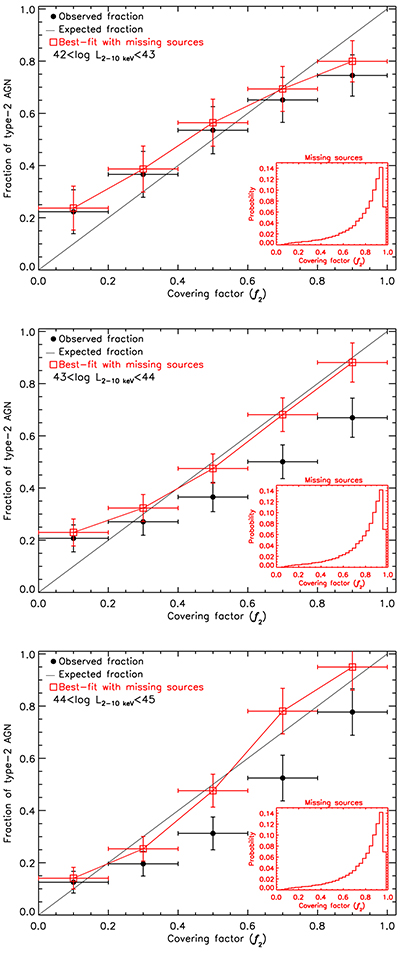ING web news release
10 July, 2017
A Large Fraction of Rapidly-Growing Supermassive Black Holes Evade Census
Highly obscured and rapidly growing supermassive black holes (SMBH), known as active galactic nuclei (AGN), might represent the key phase when SMBH accreted most of their mass and when the relationship between galaxies and their central SMBHs was established. A new study by an international team of astronomers led by Dr Silvia Mateos from the Instituto de Física de Cantabria (CSIC-UC) in Spain, now suggests that many of the brightest SMBH may be escaping our detection as they hide in heavily obscured environments.
A large observational effort has been devoted to reveal the obscured AGN phase across the history of the Universe. Oddly enough, most AGN searches, mainly at X-ray wavelengths, report that obscured AGN (optically classified as type 2) become rarer with increasing accretion power. The receding torus model hypothesis is often invoked to explain this lack of luminous highly obscured AGN. It postulates that the most luminous AGN erode the obscuring material located in the vicinity of the SMBH, the so-called "dusty torus", reducing its covering factor. As a result, higher luminosity AGN should be rarely hidden from our view by the dusty torus.
A completely different picture emerges now. Based on observations from both ground and space instruments, including spectroscopic observations with ISIS and ACAM on the William Herschel Telescope (WHT) and the European Photon Imaging Camera onboard the XMM-Newton observatory, the team led by Mateos built a sample of approximately 200 X-ray selected AGN from the Bright Ultra-hard XMM-Newton Survey (BUXS). Using models that self-consistently reproduce the emission from dust in the torus heated by the AGN, they determined for each AGN in their sample the fraction of the sky around the AGN central engine that is obscured, i.e., the geometrical covering factor of the dusty torus. The combined torus covering factor over the entire AGN population is precisely the intrinsic fraction of type 2 AGN.
By equating the distribution of torus covering factors to the observed fraction of type 2 AGN in BUXS the team finds that many type 2 AGN with high covering factor tori have escaped detection in X-rays. Most importantly, these elusive AGN are increasingly numerous at higher AGN luminosities. When they account for the "missing" AGN, the team finds an intrinsic fraction of type 2 AGN of 58% with no (or at most a weak) dependence with AGN luminosity over three orders of magnitude in luminosity.
|
 |
Fraction of type 2 AGN versus the torus covering factor in three bins of AGN X-ray luminosity. Filled circles are the observed fraction of type 2 AGN in BUXS. The black solid line represents the 1:1 relation expected if BUXS did not miss any type 2 AGN. Open squares are our best-fit models to the 1:1 relation after including the missing type 2 sources. The insets show the probability density distribution of the torus' covering factor assumed for these missed sources (Mateos et al., 2017).
Large format: JPEG.
|
According to Silvia Mateos, who led the research: "Clearly, the impact of the enormous AGN accretion power on the geometry of the nuclear material surrounding the SMBH is not as strong as we thought. Instead, a large fraction of luminous rapidly growing SMBH are so deeply embedded that they are escaping X-ray detection".
The work by Mateos et al. indicates that a numerous population of powerful AGN are inconspicuously lurking in galaxy centres, and implications for the evolution of galaxies may be significant.
More information:
S. Mateos, F. J. Carrera, X. Barcons, A. Alonso-Herrero, A. Hernán-Caballero, M. Page, C. Ramos Almeida, A. Caccianiga, T. Miyaji and A. Blain, 2017,
"Survival of the obscuring torus in the most powerful active galactic nuclei", ApJL, 841, 18 [ ADS ]
"Hidden Black Holes Revealed?", AAS NOVA, 19th June 2017.
|
|



